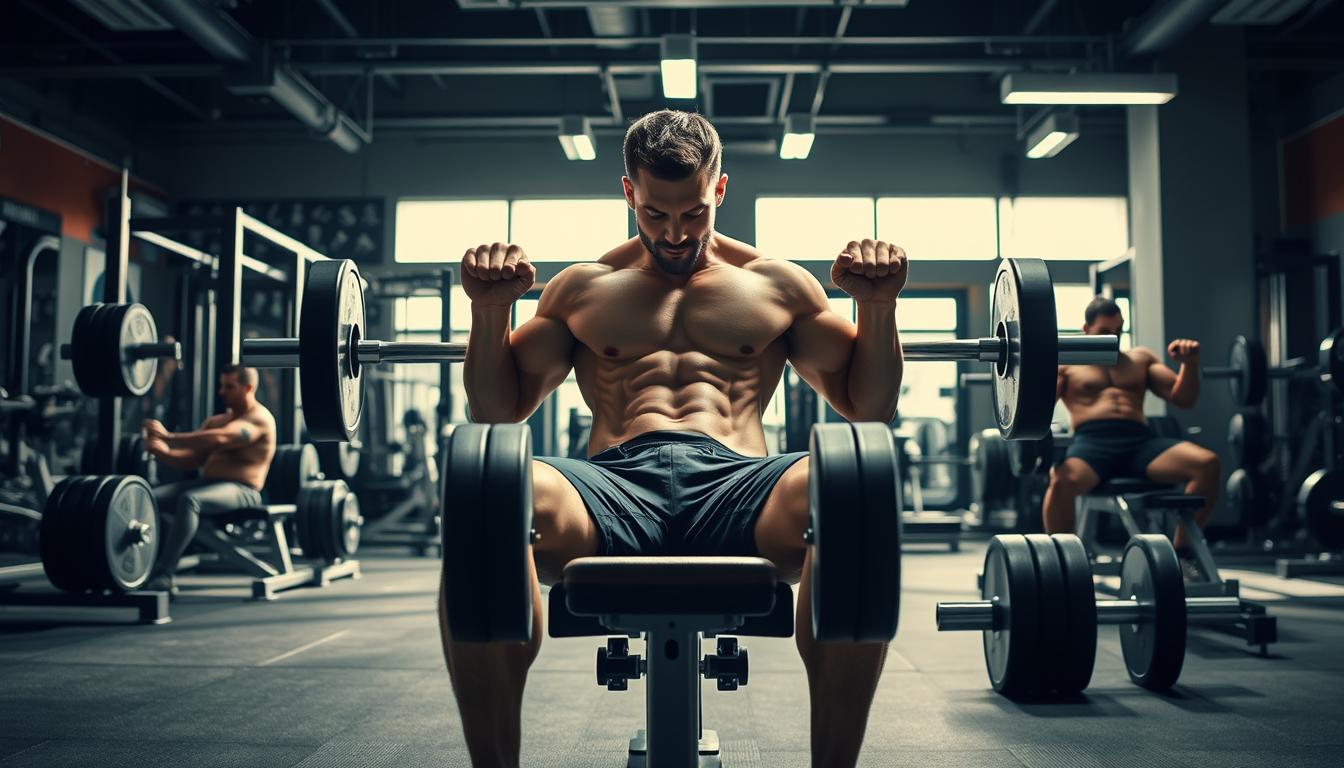Building a strong chest isn’t just for looks; it’s essential for overall upper body strength and functionality. By incorporating barbell chest exercises into your muscle-building workouts, you can effectively engage and develop your chest muscles. These workouts offer a structured chest training regimen that helps in targeting and activating different parts of the chest, leading to balanced muscle growth and strength gains.
Barbell exercises act as a cornerstone in any effective muscle-building routine because they allow for progressive overload and improved muscle activation. Moreover, they can be tailored to fit various fitness levels and goals. For more detailed insights, you can refer to this comprehensive guide on the best chest.
Key Takeaways
- Incorporate barbell exercises to target different areas of the chest.
- Effective for both muscle growth and strength enhancement.
- Progressive overload is key for continual improvement.
- Can be adjusted for various skill levels and fitness goals.
- Balanced chest development improves overall upper body functionality.
Introduction to Barbell Workouts for Chest
When it comes to effective chest development, barbell workouts are a powerful choice. These exercises provide a unique capability to handle heavy weights, which is essential for stimulating muscle hypertrophy and achieving substantial growth in the pectoral muscles.
Why Choose Barbell Exercises
The benefits of barbell exercises are numerous. They allow for progressive loading, meaning you can continually increase the weight to keep challenging your muscles. This constant progression is a key factor in achieving significant muscle hypertrophy. Additionally, barbell exercises engage multiple muscle groups simultaneously, providing a more comprehensive workout that targets the entire pectoral muscle anatomy.
The Science Behind Chest Muscle Growth
Understanding the pectoral muscle anatomy is crucial for effective chest workouts. The pectoralis major, the primary muscle in the chest, consists of two parts: the clavicular head (upper chest) and the sternal head (lower chest). When performing barbell exercises, both parts are activated, leading to balanced muscle development.
Resistance training, such as barbell workouts, triggers muscle hypertrophy through muscle fiber recruitment and adaptation. By incorporating exercises like the bench press, you not only improve strength but also maximize muscle growth. For a comprehensive approach, consider integrating these principles with cable workouts for arms explored here, which also play a role in enhancing muscle definition and ensuring balanced development.
Bench Press Techniques
Mastering the bench press requires attention to technique, understanding variations, and knowing common mistakes. A well-rounded approach ensures maximum benefit and reduced injury risk.
Proper Form and Setup
Attaining the ideal bench press form starts with the correct setup. Position yourself on the bench with your eyes directly under the bar. Maintain a tight grip, about shoulder-width apart, ensuring your wrists are straight and your knuckles face upward. Your feet should be flat on the floor, creating a stable base without any movement.
- Grip: Firm and even, wrist straight.
- Position: Eyes under the bar, feet flat on the ground.
- Movement: Lower the bar slowly to your chest and press upwards with power.
Variations and Their Benefits
Exploring barbell bench variations enhances muscle development and breaks through plateaus. Each variation targets different parts of the chest.
- Close-Grip Bench Press: Emphasizes the triceps while still engaging the chest.
- Wide-Grip Bench Press: Puts more stress on the chest muscles, particularly the pecs.
- Reverse-Grip Bench Press: Enhances upper chest activation and reduces shoulder stress.
Common Mistakes to Avoid
Avoiding bench pressing errors is crucial for safety and effectiveness. Common mistakes include:
- Improper Grip: Too narrow or wide can cause wrist and elbow strain.
- Arching the Back: Leads to poor form and potential lower back injury.
- Bouncing the Bar: Reduces muscle engagement and increases the risk of injury.
- Feet Movement: Stability is key; keep your feet firmly planted.
Addressing these errors helps ensure that you’re getting the most out of your routine while keeping your joints and muscles safe.
Incline Barbell Press for Upper Chest
Mastering the incline barbell press is essential for developing well-rounded upper pectoral muscles. This exercise specifically targets the upper chest area, which can sometimes be neglected in more traditional flat bench press routines.
Targeting the Upper Chest Muscles
By adjusting the bench to an incline, the focus shifts towards the upper pectoral muscles. The ideal angle for this exercise is typically between 30 to 45 degrees. Press angle adjustments within this range can help you find the most effective position to maximize muscle engagement and growth.

The incline bench press doesn’t only activate the pectoralis major, but also engages the deltoids and triceps. Correct form is crucial to ensure the upper chest takes most of the load, which involves retracting the scapula, controlled lowering of the barbell, and a strong push back to the starting position without locking out the elbows.
Incline Press Variations
To keep your upper pectoral workouts dynamic, it’s beneficial to incorporate different incline press variations. Changing your grip width can significantly impact which parts of the chest are activated.
- Wide grip: Emphasizes the outer portion of the chest.
- Narrow grip: Places more stress on the triceps and inner chest.
Additionally, you can alternate between barbell and dumbbell incline presses. Dumbbells allow for a greater range of motion and require more stabilization, adding a new challenge to your routine. These variations ensure continuous muscle adaptation and growth, keeping your upper pectoral workouts both effective and engaging.
Decline Barbell Press for Lower Chest
Incorporating the decline barbell press into your workout routine can significantly enhance your lower chest muscle targeting. This exercise is exceptionally effective for developing the lower pectoral muscles, giving your chest a more defined and balanced appearance.
Advantages of Decline Press
The decline bench press benefits your workout routine by emphasizing the lower part of your pectoral muscles, which are often underutilized in standard chest exercises. By positioning your body at a downward angle, you allow gravity to engage the lower chest more effectively, leading to enhanced muscle growth and definition.
- Improved muscle activation in the lower pectorals
- Enhanced overall chest symmetry
- Reduced strain on the shoulders compared to flat and incline presses
Execution Tips
To maximize the decline bench press benefits, it is crucial to perform the decline press technique correctly:
- Set the bench to a 15-30 degree decline angle.
- Ensure your feet are securely placed on the footpads to maintain stability.
- Grip the barbell slightly wider than shoulder-width apart.
- Lower the barbell slowly to your lower chest, keeping your elbows at about a 45-degree angle from your body.
- Press the barbell back up explosively while maintaining control throughout the movement.
By following these tips, you can effectively target the lower chest muscles and enjoy the full spectrum of decline bench press benefits.
Barbell Pullovers for Chest Expansion
The barbell pullover is a versatile and effective exercise that is often overlooked in chest workouts. Known for its unique benefits, this exercise is particularly valuable for achieving ribcage expansion and enhancing thoracic mobility. Let’s delve deeper into the correct pullover technique, ensuring you can incorporate chest pullovers into your routine effectively.
To perform a barbell pullover correctly, start by lying flat on a bench, holding a barbell with a grip slightly narrower than shoulder-width. Ensure your head is positioned at the edge of the bench. Slowly lower the barbell behind your head while keeping your arms slightly bent. This action will stretch your pectoral muscles and promote ribcage expansion. Bring the barbell back up to the starting position by engaging your chest and lats.
Here are the key steps for executing the pullover technique correctly:
- Lie flat on a bench with your head at the edge.
- Hold the barbell with a grip narrower than shoulder-width.
- Lower the barbell behind your head with arms slightly bent.
- Engage chest and lats to bring the barbell back to the starting position.
Incorporating chest pullovers into your workout regimen not only targets the pectoral muscles but also facilitates significant ribcage expansion, which can enhance your overall breathing capacity and thoracic flexibility.
Barbell Floor Press for Strength Gains
Engaging in strength improvement exercises like the barbell floor press can amplify your gains, especially for those dealing with shoulder issues or limited range of motion. This exercise benefits lifters by focusing on the triceps, chest, and shoulders as they perform the movement from the floor.
Why Floor Press is Effective
The barbell floor press benefits are numerous. It minimizes shoulder stress, making it a safer alternative for individuals who have previous injuries. Additionally, the reduced range of motion isolates the triceps, leading to better strength gains in your upper body. Many lifters find that this exercise complements their existing routines, promoting a more balanced development of their chest and triceps.
How to Perform the Barbell Floor Press
To properly execute the floor press form, follow these steps:
- Lie on your back, positioning the barbell above your chest with bent knees.
- Grip the barbell with hands slightly wider than shoulder-width apart.
- Lower the barbell until your upper arms touch the floor, maintaining a controlled descent.
- Press the barbell back up to the starting position by extending your arms fully.
- Ensure consistent breathing patterns: inhale during the descent and exhale as you press upwards.
Integrating the barbell floor press into your routine can significantly enhance your strength improvement exercises, pushing your limits safely and effectively.
Chest Hypertrophy Training Techniques
Optimizing chest hypertrophy requires a comprehensive understanding of the underlying principles. Leveraging effective workout programming, one can significantly elevate muscle growth and strength in the chest area.
Understanding Hypertrophy
Muscle hypertrophy is the process of enlarging muscle fibers through repetitive stress caused by resistance training. The hypertrophy principles dictate that achieving optimal growth involves balancing volume, intensity, and frequency. By adhering to these principles, I can ensure my training routines are tailored for maximum muscle gain.
Incorporating Barbell Exercises
Exercise selection for growth is crucial when aiming for chest hypertrophy. Barbell exercises like bench press, incline press, and barbell pullovers are highly effective. These movements engage multiple muscle groups, leading to a more comprehensive workout. Including a variety of barbell exercises allows me to target different parts of the chest efficiently.
Training Frequency and Volume
Effective workout programming involves setting the right training frequency and volume. For muscle hypertrophy, training each muscle group two to three times per week with sufficient volume is beneficial. For instance, performing 3-4 sets of 8-12 repetitions per exercise ensures an optimal load for growth. It’s essential to adjust the frequency and volume based on individual recovery and progress.
| Training Parameter | Recommendation |
|---|---|
| Frequency | 2-3 times per week |
| Volume | 3-4 sets of 8-12 reps |
| Key Exercises | Bench Press, Incline Press, Barbell Pullovers |
Barbell Compound Exercises for Chest
Incorporating barbell compound movements into your chest workout routine offers numerous benefits, helping to build functional strength and overall muscle development. These exercises not only target the chest but also engage multiple joints and muscle groups, making them efficient and effective.
By focusing on multi-joint exercises, you are able to maximize your workout intensity and overall muscle recruitment. Exercises such as the barbell bench press are fundamental compound movements that engage the chest, shoulders, and triceps. Incorporating these exercises aids in achieving a well-rounded upper body strength and definition.
Another key component of barbell compound exercises is their role in enhancing functional strength. Movements like the incline barbell press and decline barbell press offer variations that specifically target different areas of the chest while still engaging multiple muscle groups. This holistic approach to chest training ensures that the muscles work in a coordinated manner, simulating real-life activities and improving overall athletic performance.
Here are some essential barbell compound exercises for your chest training:
- Flat Barbell Bench Press
- Incline Barbell Press
- Decline Barbell Press
- Barbell Floor Press
The table below outlines the benefits of these compound movements:
| Exercise | Primary Muscles Worked | Secondary Muscles Worked | Benefits |
|---|---|---|---|
| Flat Barbell Bench Press | Chest | Shoulders, Triceps | Builds overall chest strength |
| Incline Barbell Press | Upper Chest | Shoulders, Triceps | Targets upper chest for balanced development |
| Decline Barbell Press | Lower Chest | Shoulders, Triceps | Focuses on lower chest, enhancing definition |
| Barbell Floor Press | Chest | Triceps, Shoulders | Improves lock-out strength and stability |
Strength Training for Chest with Barbells
Developing a formidable chest requires a well-rounded strength-focused routine. By leveraging the principles of maximal strength programs and progressive overload, you can significantly enhance your chest strength. Below, I outline essential strength-building tips to help you build an effective routine.
Building a Strength-Focused Routine
When creating a maximal strength program for your chest, focusing on compound barbell exercises like the bench press, incline press, and decline press is crucial. These exercises engage multiple muscle groups, promoting overall strength gains. Additionally, maintaining a balance between pushing and pulling movements ensures muscle harmony and reduces injury risk.
- Bench Press: A foundational move targeting the entire chest.
- Incline Press: Emphasizes the upper chest, essential for a well-defined pectoral region.
- Decline Press: Targets the lower chest, adding depth to your chest muscle.
Progression Strategies
Employing progressive overload is fundamental in any strength-training routine. This principle involves gradually increasing the weight, frequency, or number of repetitions in your workouts to stimulate muscle growth. Here are some effective progression strategies:
- Linear Progression: Incrementally add weight each week.
- Wave Loading: Cycle between heavy and light weights over multiple weeks.
- Volume Accumulation: Increase the number of sets or reps at the same weight over time.
Tracking your progression is imperative. Use a workout journal or digital app to record your weights, sets, and reps. This will help you monitor your progress and make precise adjustments as needed.

| Exercise | Sets | Reps | Rest |
|---|---|---|---|
| Bench Press | 4 | 6-8 | 2-3 minutes |
| Incline Barbell Press | 4 | 6-8 | 2-3 minutes |
| Decline Barbell Press | 3 | 8-10 | 2-3 minutes |
By meticulously planning and executing your strength-training routine with barbells, you can effectively build a powerful chest and achieve your fitness goals.
Powerlifting Chest Routines
Chest-focused powerlifting routines are specifically designed to build incredible chest strength and size. By integrating key powerlifting techniques, one can significantly enhance chest muscles, transforming a typical workout into a powerhouse of strength sports performance.
Powerlifting techniques that focus on the chest heavily rely on fundamental barbell exercises. Below is a comprehensive comparison of essential exercises utilized by elite powerlifters:
| Exercise | Primary Muscle | Secondary Muscle | Benefits |
|---|---|---|---|
| Bench Press | Pectoralis major | Triceps, Shoulders | Core chest strength |
| Incline Bench Press | Upper Chest | Shoulders, Triceps | Target upper chest |
| Decline Bench Press | Lower Chest | Triceps, Shoulders | Develop lower chest |
| Close-Grip Bench Press | Chest | Triceps | Enhance triceps strength |
You can explore more about compound exercises for the back that complement chest-focused routines.
Consistency and progressive overload are paramount in any chest-focused powerlifting program. By steadily increasing weight and refining form, you will witness substantial gains not only in muscle size but also in overall strength, thus excelling in strength sports. Keep in mind, technique and form should never be compromised for heavier weights.
Stay committed to your powerlifting chest routines, and the results will speak for themselves, providing you with the robust physique and formidable strength worthy of competition standards.
Conclusion
In wrapping up, effective chest workouts using barbell techniques offer a comprehensive approach to building muscle and enhancing strength. Throughout this article, we’ve covered various exercises, including the bench press, incline and decline barbell presses, and barbell pullovers. Each of these exercises targets different areas of the chest, providing a balanced and thorough muscle development strategy.
Understanding the proper execution and variations of these exercises is crucial. From mastering the basic bench press to incorporating incline and decline variations, every motion contributes to a well-rounded chest workout. Furthermore, incorporating barbell floor presses and compound exercises into your routine can significantly enhance your strength training results.
As you embark on your fitness journey, applying these barbell training summary techniques will optimize your workouts. Remember, consistency and proper form are key to maximizing muscle growth and achieving your desired results. Embrace these strategies, stay committed, and watch as your chest muscles develop with each session at the gym.
FAQ
What benefits do barbell chest exercises offer?
Barbell chest exercises are highly effective for muscle-building workouts and chest training regimens. They allow for heavier weight loading, engage multiple muscle groups, and foster significant strength and hypertrophy in the chest muscles.
Why should I include compound exercises in my chest routine?
Compound barbell exercises for the chest, such as the bench press, target multiple joints and muscle groups. These movements contribute to functional strength and overall muscle development, making them essential for a balanced and effective workout program.
How can I improve my bench press technique?
To improve your bench press technique, focus on proper form and setup, which includes the correct grip width and body positioning. Exploring variations and addressing common mistakes will also enhance your overall execution and safety.
What is the advantage of incline barbell presses for upper chest development?
Incline barbell presses are excellent for targeting the upper pectoral muscles. Adjusting the bench angle can optimize upper chest activation, while incorporating different grip widths and variations can further diversify and challenge your workout routine.
How does decline barbell press benefit lower chest muscles?
The decline barbell press specifically targets the lower chest muscles. By maintaining proper form and following execution tips, you can effectively incorporate this exercise into your routine to achieve balanced chest development.
Why are barbell pullovers included in chest workouts?
Barbell pullovers are beneficial for chest expansion and ribcage mobility. Performing this exercise correctly can enhance thoracic flexibility and overall chest development, complementing other traditional chest exercises.
What makes the barbell floor press effective for strength gains?
The barbell floor press is a great exercise for building strength, especially for individuals with shoulder issues or limited ranges of motion. It emphasizes proper arm positioning and controlled breathing patterns to maximize strength improvement.
How do I design a chest hypertrophy training program?
Understanding the principles of hypertrophy, including exercise selection, volume, intensity, and frequency, is vital. Incorporating various barbell exercises and following a well-structured program can significantly enhance muscle growth in the chest.
What is the best way to structure a strength-focused chest routine with barbells?
Building a strength-focused routine involves progressive overload and careful exercise selection. Monitoring your progress, adjusting weights, and ensuring a balance between intensity and recovery will help maximize your chest strength gains over time.
How are powerlifting chest routines different from regular strength training?
Powerlifting chest routines emphasize maximal strength gain and often include specific barbell exercises used in competition. These routines are tailored to develop impressive chest strength and size, suitable for performance in strength sports.







